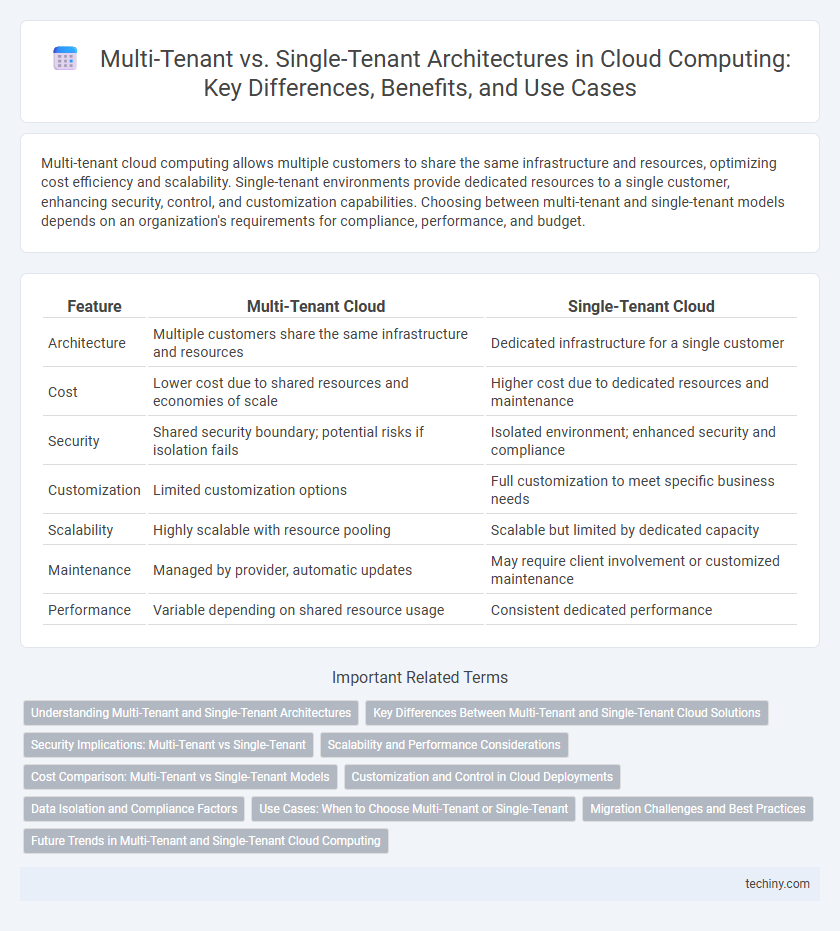Multi-tenant cloud computing allows multiple customers to share the same infrastructure and resources, optimizing cost efficiency and scalability. Single-tenant environments provide dedicated resources to a single customer, enhancing security, control, and customization capabilities. Choosing between multi-tenant and single-tenant models depends on an organization's requirements for compliance, performance, and budget.
Table of Comparison
| Feature | Multi-Tenant Cloud | Single-Tenant Cloud |
|---|---|---|
| Architecture | Multiple customers share the same infrastructure and resources | Dedicated infrastructure for a single customer |
| Cost | Lower cost due to shared resources and economies of scale | Higher cost due to dedicated resources and maintenance |
| Security | Shared security boundary; potential risks if isolation fails | Isolated environment; enhanced security and compliance |
| Customization | Limited customization options | Full customization to meet specific business needs |
| Scalability | Highly scalable with resource pooling | Scalable but limited by dedicated capacity |
| Maintenance | Managed by provider, automatic updates | May require client involvement or customized maintenance |
| Performance | Variable depending on shared resource usage | Consistent dedicated performance |
Understanding Multi-Tenant and Single-Tenant Architectures
Multi-tenant architecture enables multiple customers to share the same software application and infrastructure while keeping their data isolated, maximizing resource efficiency and cost-effectiveness. Single-tenant architecture provides each customer with a dedicated instance of the application and infrastructure, offering enhanced customization and security at a higher operational cost. Understanding these architectures helps businesses choose between scalability and control based on their compliance, performance, and budget requirements.
Key Differences Between Multi-Tenant and Single-Tenant Cloud Solutions
Multi-tenant cloud solutions enable multiple customers to share the same infrastructure and resources, optimizing cost-efficiency and scalability while potentially introducing security and customization limitations. Single-tenant cloud solutions dedicate infrastructure to a single customer, offering enhanced security, customization, and performance at a higher cost and with less resource sharing. Key differences include resource isolation, cost structure, security levels, and flexibility in customization tailored to specific business needs.
Security Implications: Multi-Tenant vs Single-Tenant
Multi-tenant cloud environments share computing resources among multiple users, increasing the risk of data breaches and unauthorized access due to resource co-location and potential vulnerabilities in isolation mechanisms. Single-tenant architectures allocate dedicated resources to one user, enhancing security by minimizing attack surfaces and allowing for tailored access controls and compliance measures. Organizations handling sensitive data often prefer single-tenant solutions to meet stringent regulatory requirements and maintain data sovereignty.
Scalability and Performance Considerations
Multi-tenant cloud environments offer enhanced scalability by sharing resources across multiple users, enabling rapid provisioning and efficient utilization of infrastructure. Single-tenant architectures provide dedicated resources, ensuring consistent performance and better isolation, which is crucial for latency-sensitive and compliance-heavy applications. Balancing resource allocation between scalability and performance depends on workload demands and specific business requirements in cloud computing deployments.
Cost Comparison: Multi-Tenant vs Single-Tenant Models
Multi-tenant cloud computing significantly reduces infrastructure costs by sharing resources across multiple users, enabling lower operational expenses and improved scalability. Single-tenant models involve higher costs due to dedicated hardware and maintenance requirements, but offer enhanced security and customization. Choosing between multi-tenant and single-tenant architectures depends on balancing cost efficiency with specific business needs for isolation and control.
Customization and Control in Cloud Deployments
Multi-tenant cloud deployments offer limited customization as resources and configurations are shared among multiple users, resulting in standardized environments that streamline maintenance but restrict individual control. In contrast, single-tenant architectures provide complete customization capabilities and greater administrative control, enabling organizations to tailor security settings, software stacks, and resource allocation to specific business needs. Enterprises prioritizing regulatory compliance and bespoke application requirements often prefer single-tenant environments for enhanced governance and flexibility.
Data Isolation and Compliance Factors
Multi-tenant cloud environments share infrastructure and resources among multiple customers, requiring robust data isolation mechanisms such as encryption, access controls, and virtualized environments to prevent data leakage and ensure compliance with regulations like GDPR and HIPAA. Single-tenant cloud solutions dedicate infrastructure to a single organization, offering enhanced data isolation that simplifies compliance management and reduces the risk of cross-tenant data breaches. Organizations with stringent regulatory requirements or sensitive data often prefer single-tenant architectures for greater control over security policies and audit capabilities.
Use Cases: When to Choose Multi-Tenant or Single-Tenant
Multi-tenant architecture is ideal for SaaS providers targeting cost-effective scalability, enabling multiple customers to share resources while reducing operational expenses. Single-tenant environments suit organizations with stringent compliance requirements, high customization needs, or sensitive data, offering isolated infrastructure and enhanced security. Choosing multi-tenant models benefits startups and small businesses seeking agility, whereas single-tenant setups cater to enterprises demanding dedicated resources and performance guarantees.
Migration Challenges and Best Practices
Migration from single-tenant to multi-tenant cloud environments poses challenges such as data isolation, security compliance, and application architecture redesign to support shared resources. Best practices include thorough tenant data segmentation, deploying robust access controls, and leveraging containerization or microservices to facilitate scalable and secure resource sharing. Prioritizing automated testing and continuous monitoring ensures a smooth transition while minimizing downtime and performance degradation.
Future Trends in Multi-Tenant and Single-Tenant Cloud Computing
Multi-tenant cloud computing is evolving with enhanced security protocols and AI-driven resource allocation to support high scalability and cost-efficiency for diverse user groups. Single-tenant cloud deployments are trending towards hybrid models integrating dedicated resources with edge computing to optimize performance and compliance for sensitive workloads. Future developments will see increasing adoption of containerization and serverless architectures across both models, driving flexibility and operational agility in cloud infrastructure.
Multi-Tenant vs Single-Tenant Infographic

 techiny.com
techiny.com